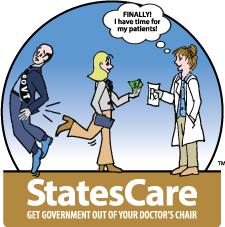
Five Bogus Healthcare Narratives and One True
By Deane Waldman, MD MBA - 25/07/20
There are so many compelling narratives about healthcare, people simply can't distinguish truth from falsehood. Without knowing the facts about healthcare, we cannot fix it. Following are five examples of commonly accepted wisdom that are bogus, myths, and one true narrative.
CoViD-19 is like Ebola
CoViD-19, the "new flu" (my phrase), is just that: a new respiratory illness that has a propensity to attack and kill the weakest members of our human herd, those with sever pre-existing conditions like immune deficiency, diabetes, chronic lung disease, all usually found in our elderly population within nursing homes. Data from here and from Italy suggest that 73-88 percent of the deceased died with, not because of CoViD-19 infection. Thus, the 150,000 deaths attributed to CoViD-19 were actually 18,000 to 40,000 deaths caused by the virus, i.e., fewer deaths than during either of the last two flu epidemics.
CoViD-19 has been compared to Ebola. Many Americans fear the likelihood of death because of this media-fostered hysteria. Ebola has a case fatality rate (CFR) of 90 percent meaning most who contract it will die, horribly and quickly. By contrast, in the general population, CoViD-19 has a CFR of 0.2 percent just like the flu. In other words, absent a pre-existing condition, you chance of death from CoViD-19 is 2 in 1000.
The comparison of CoViD-19 to Ebola is bogus.
Build on ACA success
Former President Obama said he started healthcare reform in order to bend down the national healthcare spending curve and make insurance affordable. Hence, the law's name. Yet, the annual cost of health insurance for an average family has jumped from $12,680 in 2008 to $28,166 in 2018. Obamacare will expend an additional $1.76 trillion and has doubled the national debt.
Democrats urge that we build on the ACA's one success: a drop in the U.S. uninsured rate from 17.1 percent to the current 8.8 percent, before millions lost their employer-supported insurance with the CoViD-19 economic shutdown. The real problem is that as no charge insurance coverage went up, access to care went down. The average maximum wait time to see a physician went from 99 day to 176 days.
The success claimed for the ACA is bogus.
Healthcare success means insuring everyone
The reason we have a healthcare system is to provide care, no to provide insurance coverage. Insurance is touted as the key to getting care but this another false (bogus) narrative.
While uninsured people do get care, insured people often do not! In fact, people with government insurance such as Medicaid and Tricare die while waiting in line for care. According to an internal VA audit, "47,000 veterans may have died" waiting for medical care.
Second fundamental flaw: the government has only one way to control costs: medical rationing. It reduces reimbursement schedules to providers, limits payments to institutions, and denies authorization for expensive treatments. As a result, wait times to see a family physician are now more than four months, almost half of U.S. physicians cannot afford to accept new Medicaid patients, and "47,000 veterans may have died waiting for care."
Death-by-queueing means that technically possible, life-saving care was not provided in time to prevent death. The patient with a treatable condition dies while waiting in line, what the British call a queue.
Clearly, being insured does not lead to timely, and sometimes any, medical care.
Other countries have the answer
We are spending more than we can afford on healthcare both as a nation and as individuals. In 1960, the U.S. spent 5 percent of GDP on its healthcare system. Last year, it was more than triple, 18 percent. In 2018, the average American family spent $28,166 on healthcare, making it the most expensive item on family budgets, more than the mortgage.
Other countries typically spend half or less of what the U.S. spends. How do they do they? Simple, they use medical rationing both direct and indirect. Direct rationing means the government says only a certain number of patients can get the care they need. For the others, well, too bad. Indirect rationing refers to limiting the money for facilities and personnel. The effect is the death by queueing mentioned previously. The phrase came from Great Britain's single payer system and that is why the word queue is used rather than a line.
There are only two ways to cut costs in healthcare (or anything else): central economic control, which means government rationing; or decentralized control, meaning the free market and billions of decisions by consumers and sellers that drive down prices and elevate availability.
Washington must fix healthcare
If a football team lost every game for fifty years, would you expect them to win next year's Super Bowl? Washington has been "fixing" healthcare for more than five decades. Consider their track record before putting your faith in their next set of promises.
Washington's 1965 medical safety net for retirees, Medicare, will be insolvent within six years. What will our senior citizens do for hospital care in 2026? Medicaid was created in the same year, 1965, and fails to deliver timely care. For example, 752 enrollees in Illinois died waiting in line for life-saving medical treatment.
Washington' solution to stop hospitals from dumping uninsured patients, the Emergency Medical Transport and Labor Act of 1985, created the unfunded mandate that is now forcing hundreds of rural U.S. hospitals to close. The ACA promised to make care "Affordable," per in its title. In fact, President Obama's namesake law more than doubled the cost of insurance premiums.
With Washington's track record for fixing healthcare, Americans should look elsewhere for a solution that works. The narrative that Washington will fix healthcare is bogus.
StatesCare cures healthcare
When you accept that Washington is the cancer in healthcare, the cure becomes clear, obvious, and politically unacceptable (to the Beltway). To fix healthcare, We the Patients need to kick Washington out so we can decide for ourselves, in our states, what healthcare structure works best for us. Washington's one-size-fits-all ... does't.
Montana and Rhode Island both have one million residents. Rhode Island has 5500 MDs within 1212 square miles and three world-famous medical centers less than 45 minutes away. Montana has 1100 physicians to serve patients spread across 145,000 square miles. The closest trauma center to Helena, Montana, is in Salt Lake City, Utah, more than 8 hours' drive, assuming the roads are passable. One size most definitely does not fit all.
The true narrative is StatesCare, the one and only effective "fix" for healthcare: Eject Washington from healthcare. Let We the Patients decide their care and their spending.
Why Read This Article:
The reason we have a healthcare system is to provide care, no to provide insurance coverage.
By Deane Waldman, MD, MBA, author of "Curing the Cancer in U.S. Healthcare"
Professor Emeritus of Pediatric, Pathology, and Decision Science; former Director of Center for Healthcare Policy at Texas Public Policy Foundation; and author of award-winning, "Curing the Cancer in U.S. Healthcare: StatesCare and Market-Based Medicine."
Mailing address:
ADM Consulting & Books
PO Box 37396
Albuquerque, New Mexico 87176-7396
Copyright © 2015-2019 ADM Consulting & Books. All Rights Reserved. All other trademarks on this site are the property of their respective owners. Site design and maintenance by www.DesignStrategies.com.



